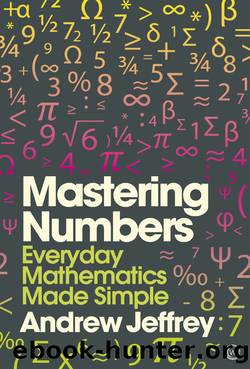Mastering Numbers by Andrew Jeffrey

Author:Andrew Jeffrey
Language: eng
Format: epub
Publisher: Watkins Media
So 176 expressed in base 3 is 20112.
THE BINARY SYSTEM (solutions on page 151)
Base 2, or the binary system, has a particular importance in science. As only the digits 0 and 1 are used, they can be indicated by “on” or “off ”, electrical impulse or no impulse, and this is the basis of all computer “brains”. The headings are 1, 2, 4, 8, etc. Can you work out:
• How the number 5 would be written in binary?
• How the binary number 110 would be written in base 10?
INTERLUDE
FAMOUS MATHEMATICIANS
Many brilliant mathematicians have helped to further our knowledge by their discoveries. Some are rightly household names, such as Isaac Newton, Archimedes and Albert Einstein, but many more have somehow escaped “superstar status”, despite their immense achievements. Here are some of the lesser-known people who have shaped not only mathematics, but the very way we think.
Marie-Sophie Germain (1776–1831) Although a hugely talented natural mathematician living in the 18th and 19th centuries, Germain was discouraged from pursuing a mathematical career because of her gender. Despite a lack of formal training, she managed to study in secret and struck up a long-lasting correspondence and later friendship with C.F. Gauss (see page 29), who praised her work on number theory and Fermat’s Last Theorem very highly. For much of her career, she pretended to be a man when corresponding with other mathematicians for fear of not being taken seriously.
Srinivasa Ramanujan (1887–1920) Little known in the West, at least outside academic circles, the Indian Ramanujan was a highly original thinker and largely self-taught. The story is told of his visit to Oxford to meet the mathematician G.H. Hardy, when he arrived in a taxi whose number was 1729. When Hardy remarked that this was a fairly dull number, Ramanujan corrected him, pointing out that 1729 was (of course) the smallest number that could be expressed as the sum of fourth powers in two different ways. But you probably spotted that!
David Blackwell (1919–2010) Born in the US, Blackwell gained a PhD in mathematics at the incredible age of 22. He was perhaps the most accomplished African American mathematician, and if he had been born 50 years later, he may well have achieved the sort of widespread fame his ability deserved. His forte was statistics, co-writing Games and Statistical Decisions in 1954. In 1965 Blackwell became the first African American in the National Academy of Sciences.
William Rowan Hamilton (1805–1865) Ireland’s most celebrated and brilliant mathematician, Hamilton devised the idea of quaternions, which allowed -1 to have not one but several square roots (see page 146). This discovery had hugely beneficial implications for mathematicians and physicists worldwide. He has never been given the recognition he deserves, partly because his idea is so complex that it is difficult for anyone but mathematicians to comprehend!
Al-Khwarizmi (c.780–c.840) This outstanding scholar from Persia made significant contributions to geography and astronomy, but is mostly remembered for his ground-breaking work on algebra. Until he started to use letters to generalize numbers, the world had relied heavily on the Greeks’ limited geometry-based mathematics.
Download
This site does not store any files on its server. We only index and link to content provided by other sites. Please contact the content providers to delete copyright contents if any and email us, we'll remove relevant links or contents immediately.
The Infinite Retina by Robert Scoble Irena Cronin(5217)
Harry Potter and the Cursed Child: The Journey by Harry Potter Theatrical Productions(4291)
The Sports Rules Book by Human Kinetics(4041)
Molly's Game: From Hollywood's Elite to Wall Street's Billionaire Boys Club, My High-Stakes Adventure in the World of Underground Poker by Molly Bloom(3313)
A Knight of the Seven Kingdoms by George R R Martin(3004)
Quidditch Through the Ages by J.K. Rowling(2971)
How To by Randall Munroe(2890)
Quidditch Through the Ages by J K Rowling & Kennilworthy Whisp(2862)
Quidditch Through the Ages by Kennilworthy Whisp by J.K. Rowling(2736)
Flowers For Algernon by Daniel Keyes(2707)
Quidditch through the Ages by J. K. Rowling(2685)
Stacked Decks by The Rotenberg Collection(2662)
Quidditch Through The Ages by J. K. Rowling(2652)
776 Stupidest Things Ever Said by Ross Petras(2565)
What If?: Serious Scientific Answers to Absurd Hypothetical Questions by Randall Munroe(2527)
Ready Player One: A Novel by Ernest Cline(2522)
Beautiful Oblivion by Jamie McGuire(2443)
The Book of Questions: Revised and Updated by Gregory Stock Ph.d(2423)
Champions of Illusion by Susana Martinez-Conde & Stephen Macknik(2304)
